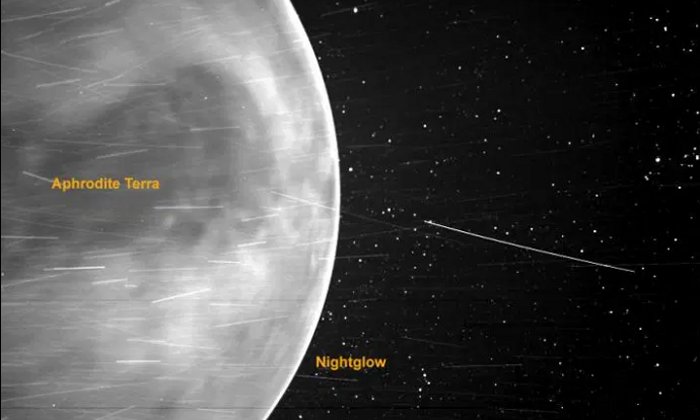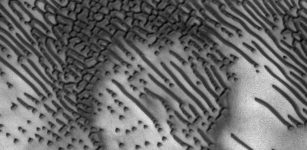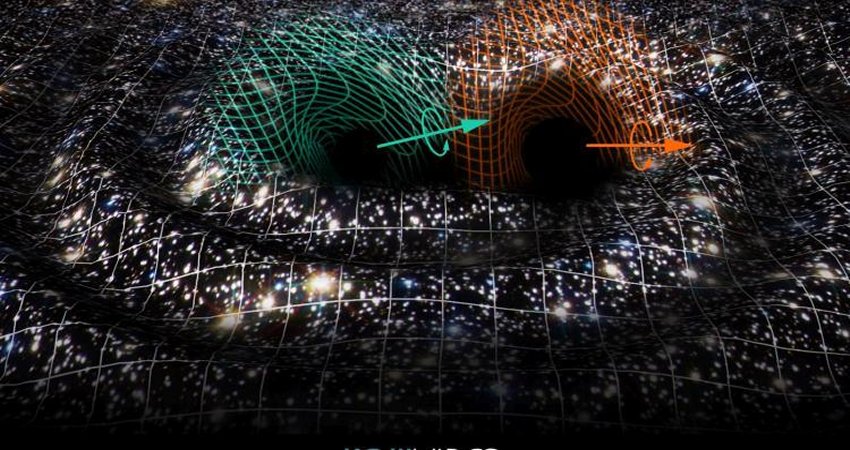Peering Through The Clouds Of Earth’s ‘Evil Twin’ Delivers Surprises
Eddie Gonzales Jr. – MessageToEagle.com – A solar probe surprised U.S. Naval Research Laboratory scientists by seeing through the planet’s clouds. Venus, sometimes called Earth’s “evil twin” since both planets are about the same size, is beset with a poisonous carbon dioxide atmosphere and a surface temperature of 878 degrees Fahrenheit (470 degrees Celsius), hot enough to melt lead.
 Credit: Photo by NASA/Johns Hopkins APL/Naval Research Laboratory/Guillermo Stenborg and Brendan Gallagher
Credit: Photo by NASA/Johns Hopkins APL/Naval Research Laboratory/Guillermo Stenborg and Brendan Gallagher
NRL’s Wide-field Imager for Parker Solar Probe (WISPR) took a stunning image of Earth’s celestial neighbor Venus last year that left researchers searching for answers as to how what they were seeing was possible. Expecting to see just the featureless Venusian clouds, the NRL WISPR team was instead shocked at what they saw.
“The puzzling part is, we expected to primarily image the Venusian clouds, but instead WISPR was able to peer through the clouds to image the surface,” Mark Linton, Ph.D., who works in NRL’s Heliophysics Theory and Modeling Section said. “On the one hand, WISPR is very sensitive to visible light. With visible, we expect only to see clouds; on the other hand, WISPR is much less sensitive to infrared light, but the infrared emission from the surface is readily transferred through the clouds.”
WISPR, the only imaging instrument on the NASA Parker Solar Probe mission records visible light images of the solar corona and heliosphere, the vast, bubble-like region of space that surrounds and is created by the sun with a pair of overlapping cameras.
The instrument captured the image of the Venus’s night side from a distance of 7,693 miles (12,380 kilometers) during the mission’s third gravity assist of the hot, hellish and volcanic planet July 11, 2020, whose surface shows up as the light and dark features in this image. The large dark features are the mountains of Aphrodite Terra, a highland region, about half the size of Africa, located near the planet’s equator.
Linton said, they are working to figure out whether these images are from the infrared emission of the surface or if they are imaging the surface in visible light.
“Whether the variances in brightness are due to differences in the visible light emitted by different chemical compositions of the surface, or if they are due to differences in the infrared light emitted by different surface temperatures, where the dark features represent cooler mountainous features, and the bright features are warmer valleys, we just are not sure,” Linton said. “Either way, this is a fascinating science opportunity for us.”
Like Icarus, the Parker Solar Probe launched in August 2018 is on a mission to fly closer to the sun than any earlier spacecraft. But along the way, the probe needs to whiz past Venus a total of seven times, with each pass pulling the spacecraft closer to the sun. And while the probe is tailored to studying the sun, if a spacecraft has to loop past our “evil twin” planet anyway, the team figured it might as well turn the instruments on.
“Observations like this are always considered a science bonus for us,” Karl Battams, Ph.D., a computational scientist in NRL’s Heliospheric Physics section said. “They’re not part of our nominal mission, but can often yield some of the most surprising results.”
In February 2021, WISPR completed its fourth Venus flyby, a maneuver which uses the planet’s gravity to pull the probe closer to the sun. During its last two orbits around the Sun, its closest approach reached down to 8,400,000 miles above the Sun’s surface.
WISPR will soon come even closer to the sun. Its next close approach is scheduled for April 29, at which time it will reach just shy of 6,500,000 miles from the sun’s surface.
Linton said, “WISPR breaks new ground with every orbit, in particular after each Venus flyby where it sets a record for closest approach by a spacecraft to the solar surface, allowing us to study previously inaccessible regions close to the origin of the solar wind.”
While the probe is whizzing about the inner solar system, the implications of its discoveries will significantly impact naval operations that rely on GPS and over the horizon radar.
“These tools can be damaged by the space weather effects resulting from the interaction of the Earth’s magnetosphere with the solar wind and with coronal mass ejections,” Linton said. “Our investigations into the sources of these phenomena are part of a broader effort to develop early warning capabilities to protect Navy and DoD assets against these effects.”
WISPR has provided many unexpected bonuses, including views of Venus and various comets, and providing new insights into the dust distribution in the near sun environment.
“WISPR certainly isn’t designed for observing solar system objects such as planets and comets, but we always try to take advantage of any opportunity we have to get novel science”, said Battams. “The recent Venus images are a perfect example of why we do this!”
Written by Eddie Gonzales Jr. – MessageToEagle.com Staff










